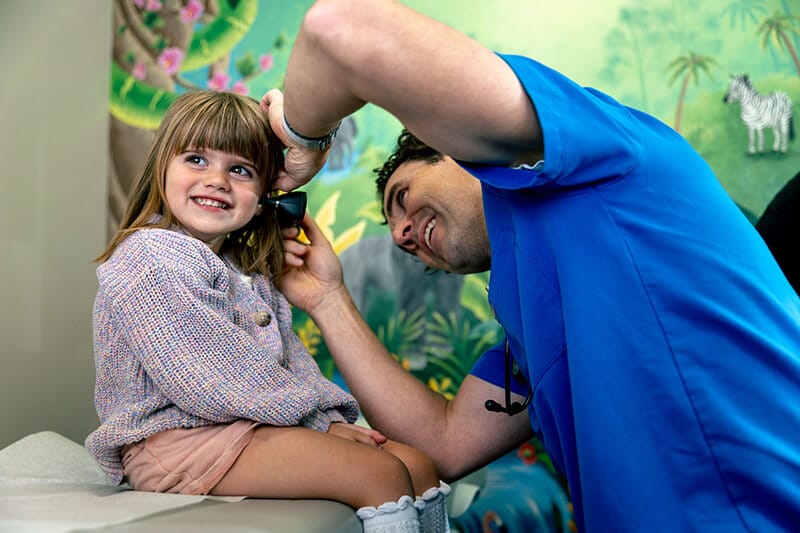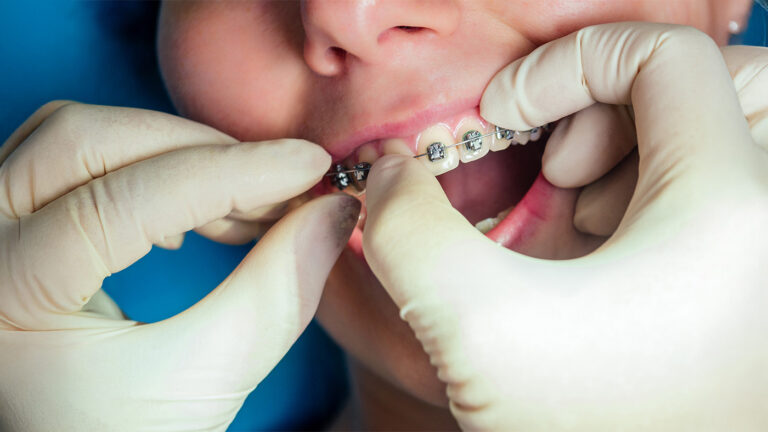The American Association of Orthodontists recommends scheduling your child’s first orthodontic visit by the time they are seven years old. At the first visit, an orthodontist will examine your child’s mouth and identify any misalignment of the teeth and/or jaws, known as malocclusions. While many malocclusions can be addressed with braces, some cases benefit from a palatal expander.
A palate expander (also called a palatal expander or orthodontic palate expander) is custom-made to fit inside the roof of the mouth and widen the upper jaw by pushing the two halves of the palate apart. When used correctly, under the supervision of an orthodontist, they are a safe and effective way to treat or prevent impacted teeth, tooth extractions, asymmetric jaw development, abnormal tooth wear, jaw misalignments, tooth crowding, and other dental issues.
Palatal Expanders at a Glance
- Palatal expanders gradually widen the upper jaw to make more room for teeth and improve the way the upper and lower teeth fit together.
- They are most commonly recommended for children and young teenagers, while the teeth and jaws are still developing.
- Depending on the case, an orthodontist may recommend different types of expanders, including rapid palatal expanders, bonded expanders, removable expanders, or surgically assisted rapid palatal expansion (SARPE).
- Most children wear a palate expander for several months, and in more severe cases, they may need to wear it for a year or more.
Why Your Child Might Need a Palatal Expander
Palatal expanders may be part of an orthodontic treatment plan, regardless of the patient’s age; however, they are most commonly used to treat children and young teenagers while their teeth and jaws are still developing.
Children typically get palatal expanders around the age of seven or eight. When applied at this stage of development, they can quickly treat certain malocclusions and prevent more complicated misalignments in the future. Your orthodontist may recommend a palatal expander if your child has one of these conditions:
- Crossbite: In a typical bite, the top teeth hang slightly over and just in front of the bottom teeth when the mouth is closed, so the very tops of the bottom teeth can’t be seen. In a crossbite, the upper teeth are positioned behind the bottom teeth when the mouth is closed. It can impact your child’s ability to chew comfortably and speak clearly.
Crossbites are similar to an underbite, but where an underbite impacts all of the teeth, a crossbite will only impact a subset. A palatal expander can address a crossbite by widening the palate and shifting the teeth so they sit in a more natural and comfortable position.
- Teeth Crowding: If the jaw is too narrow, there may not be enough room for all of the teeth to sit in their natural positions. Crowding can worsen over time as the total number of teeth increases from 20 baby teeth to 32 adult teeth.An expander can create more space in the mouth for both primary and permanent teeth to fit comfortably. By addressing crowding early on, you can prevent uneven wear and tear, as well as other dental complications.
- Impacted Teeth: Sometimes, a tooth gets stuck on its way to the surface and never emerges. If the mouth is too crowded, teeth that have already erupted can block the teeth that are still trying to emerge. When that happens, you have an impacted tooth. If the tooth remains entirely embedded in the jaw, that’s called a full bony impaction. If some of the tooth gets into the gums and some is left in the jaw, that’s called a partial bony impaction. And if a tooth grows through the jawbone but gets caught in the gums, that’s called a soft tissue impaction.
In some cases, impacted teeth cause pain, swelling, and infection. In others, there are no additional symptoms. In either case, a palatal expander creates more space in the jaw, opening up room for your child’s impacted teeth to emerge.
An orthodontic palate expander is just one tool your orthodontist may recommend as part of a comprehensive plan to guide jaw growth, reduce crowding, and create the space needed for a healthy, functional bite.
Different Kinds of Palatal Expanders and How They Work
Every palate expander is designed to push the two halves of the upper jaw apart; however, each type has its own benefits and limitations. Your child’s orthodontist will help determine the right expander for your child based on their age, specific dental conditions, and treatment needs.
Rapid Palatal Expanders (RPE)
Rapid Palatal Expanders (RPE) are the most common type and consist of metal rings or bands anchored around the molars. Those bands are then connected to a metal framework spanning across the palate. By turning a screw at the center, the framework expands, pushing against the molars and widening the palate.
Using a specialized palate expander key, you’ll turn the center screw a small amount every day, gradually expanding the palate by up to half a millimeter per day. Children typically wear an expander for a few months. Expansion typically occurs first, usually over the first three to six weeks, depending on the amount of space you need to create. Then, the expander is left in place a couple of months longer to allow the new bone to mature.
Bonded Expander
A bonded expander works the same way as a rapid palatal expander, with one major difference. Instead of metal bands, the expander is bonded directly to the teeth with a dental bonding agent. They are less invasive but are more difficult to clean and may require replacement more frequently throughout treatment.
Removable Expander
Removable expanders are similar in design and user experience to a retainer but can be made of tougher materials, such as chrome or stainless steel. If your child’s malocclusion is mild, a removable expander may be used to apply intermittent pressure and expand the jaw while also being removable for cleaning and eating.
Surgically Assisted Rapid Palatal Expansion (SARPE)
Surgically Assisted Rapid Palatal Expansion (SARPE) is used for moderate or severe childhood cases or for adults whose teeth and jaw are already finished developing. SARPE treatment couples a palatal expander with surgical cuts to help facilitate expansion.
Under local anesthesia and sedation, a surgeon cuts into the palate at the midline suture (the place where the left and right halves of the palate join) and makes additional cuts to help the palate open up and expand.
Palatal Expansion in Adults
While palatal expanders are most often used during childhood and the early teen years, palatal expansion in adults may still be possible in certain cases. When the teeth and jaw are already finished developing, options like Surgically Assisted Rapid Palatal Expansion (SARPE) may be considered. Your orthodontist will carefully evaluate your bite, jaw development, and overall oral health to determine whether an expander or another orthodontic approach is appropriate for your situation.
Because every mouth is unique, adults who are curious about palate expanders should talk directly with an orthodontist about what to expect before and after treatment, how long the process may take, and whether additional orthodontic steps—such as braces or clear aligners—might be recommended after expansion.
What to Expect from Palatal Expansion
Palatal expanders are typically worn for a few months, allowing sufficient time to create the desired space in the jaw and for it to settle into its new configuration. In severe cases, palatal expanders may need to be worn for a year or more. Treatment usually takes longer in older children and adults, as the jaw has finished developing and hardened.
In many cases, palatal expansion prevents future malocclusions, and no further orthodontic treatment is needed. In other cases, expansion creates interdental gaps, which can be corrected later with braces or other orthodontic treatments. In rare cases, patients may require additional surgeries to finalize the redistribution of the tooth and jaw material.
Your orthodontist and orthodontic care team will assess and make adjustments throughout treatment and are available to answer questions and provide guidance as you and your child navigate the path toward a brighter smile!




